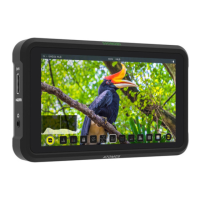
Do you have a question about the Atomos SHINOBI and is the answer not in the manual?
| Aspect ratio | 16:9 |
|---|---|
| LED backlight | - |
| Pixel density | 427 ppi |
| Display diagonal | 5.2 \ |
| Display technology | IPS |
| Input voltage | 6.2 - 16.8 V |
| Power supply type | Battery |
| Power consumption (max) | 7 W |
| Power consumption (typical) | 4 W |
| HDMI version | 1.4 |
| Headphone out | Yes |
| Product color | Black |
| Housing material | Polycarbonate (PC) |
| Connecting thread | 1/4 \ |
| Compatible memory cards | SD |
| Cables included | HDMI |
| Audio sampling rate | 48 kHz |
| Supported video modes | 720p, 2160p |
| Resolution at capture speed | 1280x720@50fps, 1920x1080@23.98fps, 1920x1080@24fps, 1920x1080@25fps, 1920x1080@59.94fps, 3840x2160@23.98fps, 3840x2160@24fps, 3840x2160@25fps, 3840x2160@29.97fps, 4096x2160@23.98fps, 4096x2160@24fps, 4096x2160@25fps |
| Depth | 31.5 mm |
|---|---|
| Width | 151 mm |
| Height | 91.5 mm |
| Weight | 196 g |
General safety advice for using the lightweight but solid device.
Details the limited warranty for ATOMOS products.
Lists conditions that void the product warranty.
Legal terms for using ATOMOS software.
Overview of the 5.2-inch HDR monitor and its features.
Lists the accessories that come with the Shinobi unit.
Advice on choosing and using appropriate HDMI cables.
Information on compatible mounting solutions for the unit.
Options for powering: Battery Eliminator, NP-F batteries, and charging.
Information on DC to D-Tap cable and battery charger.
Usage of the SD card slot for LUTs and firmware updates.
Details on the remote port for calibration and computer connection.
Information on the 3.5mm headphone jack for audio monitoring.
Description of the full-size HDMI 1.4 input for video and audio.
Details on the 1/4"-20 screw mounts for attaching the unit.
How to lock and unlock the display screen to prevent accidental touches.
Steps to update the Shinobi's firmware using an SD card.
Initial steps when connecting a signal to the Shinobi.
How to connect and use Shinobi with Video Cameras, DSLRs, and Smartphones.
Explanation of the Information Bar and its elements.
Details on Video Input, Gamut, Gamma, Audio, Battery, Monitor functions.
Managing input source, resolution, and framerate.
Matching Shinobi settings to camera output like Log/HDR, Gamma, Gamut.
Explanation of HDR and Log for advanced image processing.
Accessing and adjusting audio settings via meters.
How to check battery power and low battery warnings.
Viewing firmware version and device ID.
How to access and cycle through monitoring tools.
Adjusting parameters for monitoring tools like histograms and waveforms.
Visualizing dynamic range and exposure.
Monitoring Red, Green, Blue levels for white balance.
Monitoring Red, Green, Blue levels.
Checking color information, hue, and saturation.
Scaled-up view of the vectorscope for detailed checks.
Visualizing exposure and color distribution.
Simultaneous display of multiple monitoring scopes.
Highlighting in-focus areas for precise focus.
Identifying overexposed areas using zebra stripes.
Visualizing exposure levels with different colors.
Displaying greyscale based on the blue channel to check noise.
Punching in to check critical focus at various magnifications.
Overlaying frame guides, safe areas, and desqueeze for composition.
Steps to load .cube files and activate them.
Exploring different LOOKs and comparing them to the native source.
Displaying raw, unprocessed video.
Mapping camera gamma/gamut to panel's white for SDR.
HDR standard mapping for highlights.
HDR standard with more compression for highlights.
Using AtomOS10 to preview HDR results in the field.
Features like display off, screen flip, and screen mirroring.
Adjusting screen brightness, shadows, and highlights.
How to revert display adjustments to default.
Physical specifications including weight and size.
Details on operating power, input voltage, and battery life.
Information on the touchscreen, resolution, aspect ratio, and color.
Gamma and Gamut settings for HDR monitoring.
Specifications for HDMI input, audio ports, and supported formats.
Functionality of the SD card slot and AtomOS features.
A list of all available monitoring tools and functions.
Contents of the standard Shinobi package.